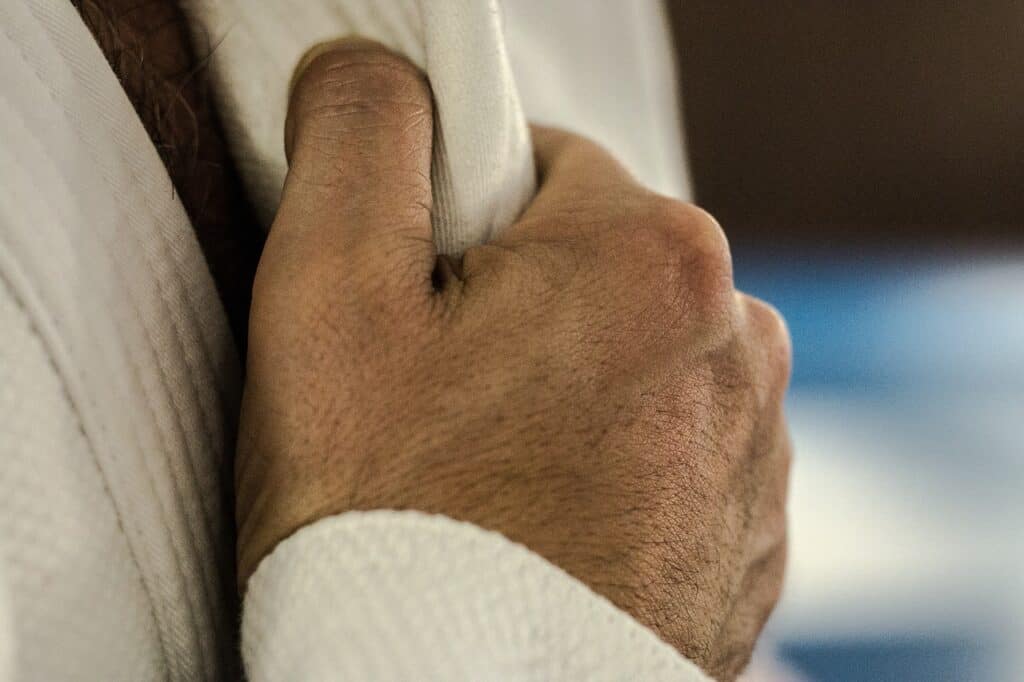
You just started Judo, or you want to start, then you’ll need to get the right uniform for the practice, even if you’ve done other martial arts before. Before you get too into Judo, you should also know the names for various things, like the uniform you wear. So then what do you call a judo uniform anyway?
You call a Judo uniform a Judogi. The Judogi includes canvas pants, a heavy jacket, and a belt. Judo typically requires a blue Judogi and a white Judogi so that competitors aren’t all wearing the same thing. The belt comes in different colors based on the person’s level in Judo.
If you want to practice Judo, you should know some of the key terms for the sport. That way, you can walk into a match or practice session and not feel confused. Keep reading to learn more about the terminology for Judo uniforms.
The Overall Judo Uniform: A Basic Overview
The name for the overall uniform in Judo is Judogi. Sometimes, you will hear the nickname “gi,” but it refers to the same thing. A Judogi has a few different parts that you should know and have for any competitions or practice sessions.
You have a jacket made of a heavy material, which you wear like a shirt, and it looks like a lot of other martial arts tops. The uniform also comes with a pair of light cotton pants. Again, the pants look similar to pants for karate, tae kwon do, and other sports.
Every Judogi should also include a belt. As with most martial arts, you have different belt colors and should wear the color that matches your rank. When you advance, you can switch out your belt for the new color.
Parts of the Judogi
When looking at a Judogi, you should be able to recognize the various parts. Some parts come into play during Judogi matches, and having names for them can help. Consider the parts of your Judogi and the terms in both Japanese and English:
- Hidari-suso-guchi (Left pant cuff)
- Suso (Skirt of the jacket)
- Migi-suso-guchi (Right pant cuff)
- Hidari-sodeguchi (Left sleeve cuff)
- Migi-sodeguchi (Right sleeve cuff)
- Hidari-yoko-obi (Left belt side)
- Ushiro-obi (Rear belt)
- Migi-yoko-obi (Right belt side)
- Mae-obi (Front belt)
- Hidari-soto-naka-sode (Left outer middle sleeve)
- Hidari-mae-eri (Left front lapel)
- Migi-soto-naka-sode (Right outer middle sleeve)
- Migi-mae-eri (Right front lapel)
- Hidari-yoko-eri (Left lapel)
- Migi-yoko-eri (Right lapel)
- Ushiro-eri (Back lapel)
As you learn Judo, you can learn different techniques that involve each part of the uniform. Knowing the terms now can help you prepare when you need to use them. That way, you can use the English or Japanese versions.
What Do Participants Wear During Judo Competitions?
When participating in Judo competitions, you can wear a special uniform. This outfit isn’t that different from the traditional dress, but the slight changes are important. If two people wear the same uniform, it can be hard to tell them apart during the match.
One person will wear the usual white Judogi with their rank belt color. However, the other person may wear a blue Judogi. This helps anyone watching differentiate between the two competitors.
Some competitions may not require a blue Judogi. Instead, they will use blue and white-colored belts to tell competitors apart. That way, the competition can still go on, but people don’t have to have two full uniforms.
What Do Judo Belt Colors Mean?
Like any other martial art, Judo belts come in different colors, and they all correspond to different ranks. In the original Kodokan judo system you would start in a light blue belt. The next color was white, and the color after that is brown or purple. Brown is the senior color, and purple is the junior color.
The junior system ends after purple. After that, juniors and seniors wear the same belt colors as they increase through the ranks. Next, you can finally reach black belt status. This color applies to all future ranks. However, some more advanced ranks can use a red and white belt or a red belt instead of a black.
Today there are different orders of belt color depending on where you live in the world. In the United States for example you would start with a white belt. Then you might get the yellow, orange, green, brown, and black. Different areas and even organizations have a different belt system.
Knowing the judo belt colors can help you know what level other people are at. While you may practice or compete against people at your same level, you never know when one of you might advance. Knowing the colors can also help if you ever want to teach Judo or watch a competition.
Kodokan Grading System
The current ranking system has been in use since 1883, and it has two major categories: kyu and dan. As you advance through the ranks, you will get different belts, but it can help to know how the ranking system works.
When you start Judo, you will be a sixth kyu (rokkyu) and wear a light blue belt to signify you’re a beginner. Once you receive enough practice, you can advance to fifth kyu (gokyu) and wear a white belt for that rank and the next rank, fourth kyu (yonkyu).
As you reach third kyu (sankyu), you will wear a brown or purple belt. You will keep that same color through the second kyu (nikkyu) and first kyu (ikkyu).
After that, you will reach the rank of first dan (shodan), where you can get a black belt. The same belt applies through the second, third, fourth, and fifth dan (nidan, sandan, yondan, godan). For sixth, seventh, and eighth dan (rokudan, nanadan, hachidan), you can wear a black belt or a red and white belt. Of course, this will look different if you are getting ranked in Europe or the United States.
Ninth, tenth, and eleventh dan (kudan, judan, juchidan) also use a black belt. At this stage, you can also wear a red belt.
How to Wear the Judogi
When you start Judo, you should make sure you wear your Judogi correctly. Putting on your uniform is fairly simple, but it’s good to make sure you are comfortable in it.
You can wear the jacket like you would any other top, but wrap the jacket’s left flap over the right flap. Leave the top untucked from your pants. You can wear the pants like a regular pair.
How to Tie the Belt
No matter what level you reach, you will need to tie your Judo belt. You can’t just wrap it around and tie a knot. There’s a very specific process you should use to tie your belt.
First, circle the belt around your waist twice and bring the ends to the front. Make sure the ends are the same length, and pull the belt around your waist tightly. It should be tight, but you also want to be able to breathe and move in it.
Thread the right end up under your belt, then keep holding it. Thread the left side up and under the belt. Wrap the left edge out and over the right end of the belt. Take the left belt, bring it down through the inner loop, then tighten both ends until a knot forms.
How Much Does A Judogi Cost?
When you first start Judo, you only need a white Judogi. You can get a blue one if you do competitions that use that system, but for now, you only need to spend about $40 or $50 on one uniform. A good example would be the Elite Sports Judogi.
As you advance, you can switch to a more expensive uniform with better quality. Some uniforms can exceed $200, but you don’t need those until you get serious about Judo. A good pick for a higher quality judogi would be the Fuji Double Weave Judogi.
Keeping Your Judo Uniform Clean
Whether you get an affordable or more expensive Judogi, you should know how to clean it. Wash your Judogi in cold water and let it hang to dry. Don’t put it in the dryer or use bleach because that can shrink your uniform or damage the cotton fibers.
Try to wash your uniform after every time you wear it. If you practice Judo every day, consider getting multiple uniforms. That way, you don’t have to wash one all of the time.For a complete guide check out my article: How To Wash A Judogi!
In Summary
A judo uniform is called a Judogi. The Judo uniform, or Judogi, is an important element of the martial art. Make sure you know the terms for the various parts of your Judogi and what your belt color means. That way, you can be comfortable and recognize other Judo competitors and their status.
